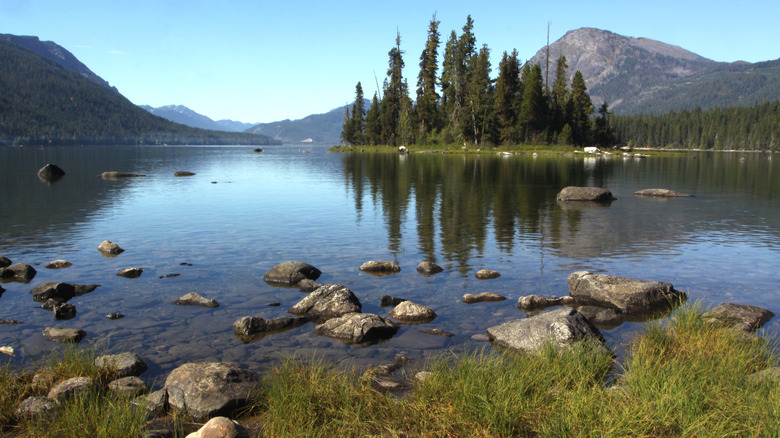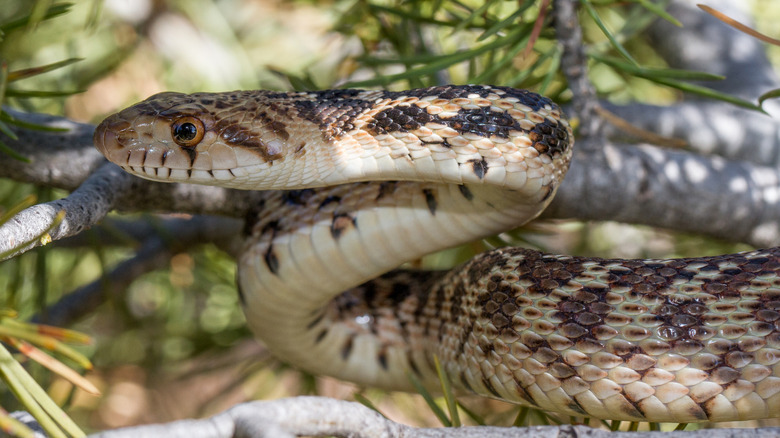Beware, Washington's Gorgeous Iconic Glacial Lake In The Cascade Mountains Is Full Of Snakes
In a state with over 8,000 lakes, you're bound to encounter a diverse array of native wildlife. Washington offers a wealth of alluring spots to cool off, including this Pearrygin Lake State Park, a wildly underrated escape for paddlers, swimmers, and stargazers. But for those who love taking a dip in natural oases, Washington's most snake-filled lakes and rivers might make you think twice before diving in. This is true for Lake Wenatchee, one of the state's most iconic glacial lakes surrounded by the Cascade Range.
Spanning nearly 2,500 acres in Lake Wenatchee State Park, the lake is a popular family destination for kayaking, horseback riding, camping, hiking, swimming, and other outdoor activities. What many visitors don't realize, however, is that it's also a haven for wildlife, including various snake species. These range from the nonvenomous garter snakes and gopher snakes to western yellow-bellied racers, which are thin and fast, and the even smaller sharp-tailed snakes, which reach about 12 inches long. Great Basin night snakes also slither about — they're venomous, but their venom is too weak to be of any real danger to humans. Rattlesnakes, though mostly found east of the Cascades, are also part of Washington's broader snake population.
Most of the snakes around Lake Wenatchee are docile and skittish. They also won't do you much harm if they bite you, but definitely shouldn't be provoked regardless. That said, if you're afraid of or disturbed by snakes in any way, this may not be the most relaxing spot for a day by the water. Some species, such as garter snakes, are often seen swimming while hunting for fish. Others may be spotted on hikes through the woods or shrubbery.
How to visit Lake Wenatchee safely with snakes
For many visitors, the snakes at Lake Wenatchee aren't a reason to avoid this picturesque and refreshing glacial lake. Encounters appear to be rare, with only one of 55 travelers on Tripadvisor mentioning them. Even that reviewer complained more about mosquitoes than any slithering friends. Still, it's worth being aware of the snakes and knowing how to coexist well enough to avoid antagonizing any into attacking.
If you encounter a snake, in the water or on land, the best response is not to panic. Simply stop and wait for it to move away. If it doesn't, back off slowly and give it plenty of space. Blocking a snake's path may prompt it to strike. Some species give clear warning signs: Garter snakes let loose foul smells to deter would-be antagonists, while rattlesnakes sound their trademark rattle when threatened. Great Basin gopher snakes even mimic rattlesnakes by shaking their tails, but they lack a rattle at the end.
Getting to Lake Wenatchee from Seattle takes about two hours in a car. At the time of writing, it costs $10 for a day pass to Lake Wenatchee State Park, with an additional fee of $7 for boats, kayaks, or other watercraft. There's a designated swimming area on the southern side and multiple hikes for taking in spectacular lake vistas. The one-hour North Lake Wenatchee Loop Trail is a popular route for lake views, though it's also notorious for mosquitoes. If spotting a snake or two doesn't appeal, Lake Sylvia State Park, Washington's hidden lakeside sanctuary and rainforest retreat, might be a better option.

